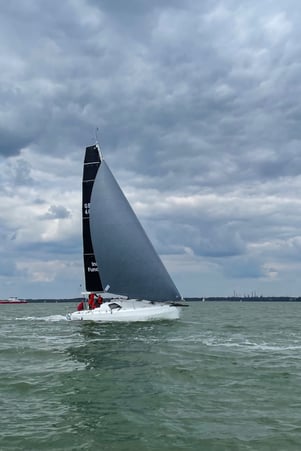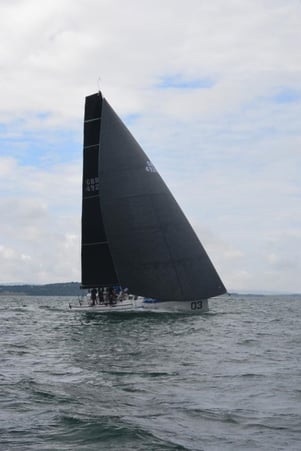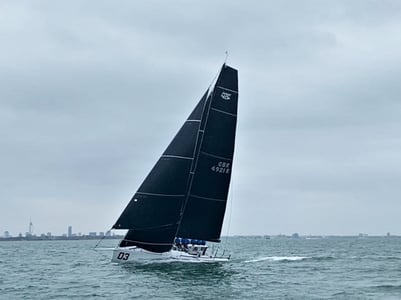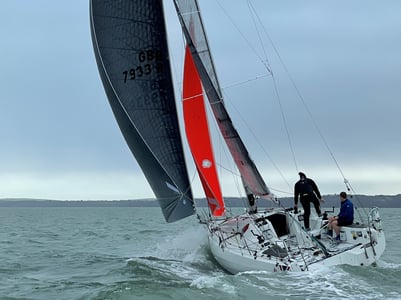-min.jpg?width=600&height=450&name=Main%20image%20(1)-min.jpg)
Image credit: Ronan Grealish
Reaching legs are an inevitable feature of coastal racing, and a good setup can produce some of the fastest and most stable sailing. We are talking about that range of off-wind angles, where an eased jib is no longer effective, but the TWA is still too tight for a spinnaker. This is where speciality reaching sails are needed. Exactly what these angles are depends on the boat and the wind strength, but for context lets assume a range of 060-120 TWA.
Different sailmakers offer a multitude of options to fill this gap and the terminology differs as much as the design philosophy. We spoke with Ronan Grealish of North Sails who has worked with numerous boats in the UK doublehanded fleet since its inception. Ronan joined North in 2007, bringing a wealth of experience from Grand Prix circuits including TP52 and Mini Maxi. Since then, he has been closely involved with the doublehanded and solo fleets, the ongoing development of the Sunfast 3300 and now the up and coming Farr X2.
Before we get started, here is a summary of the reaching sail terminology used by North:
MH0 (“mo”) = Masthead Zero
FR0 (“fro”) = Fractional Zero
BR0 (“bro”) = Blast Reaching Zero
JT = Jib Top
GS = Genoa Staysail
SS = Spinnaker Staysail
What is a Code Zero?
For many, the term ‘Code Zero’ is synonymous with the concept of a reaching sail. But in IRC racing this has a strict definition. “A Code Zero refers to a non-penalty sail under the IRC rating rule, which means that its mid girth needs to be over 75% so that it rates as a spinnaker. The hoist point can be either masthead or fractional”.
The possible operating range of a CZ is broad, from approx. 070 TWA in 7kts wind at one end of the scale, right down to 120 TWA in 20kts. “At that stage the sail is probably too flat to be effective and you can get onto a soft sail such as an A3. For most people looking for a Code Zero type sail, it’s to get them off their jib earlier so you will always endeavour to make the flattest sail you can”.
MH0 vs FR0. Who needs both?
Boats with both masthead and fractional halyards have the option of a MH0 or a FR0. Buying both doesn’t necessarily simplify matters. Both sails rate as spinnakers, so the number carried when racing is limited by the certificate. “Using the 3300 as an example, at approximately 14-15kts you can pretty much leave your MH0 behind. So a lot of these boats rate with 3 spinnakers and then for a given race decide whether to take their MH0 or FR0 depending on the expected conditions”. This is primarily due to the maximum available righting moment. “In 15kts breeze on your fractional sail, you might be able to get 10 degrees higher than you could with the masthead because you run out of righting moment on the bigger sail and are forced to sail lower.” Remember, the aim is to switch from the jib to a reaching sail as early as possible. With that in mind, there may still be a benefit to the FR0 in certain lighter conditions. “Generally the fractional sail will point a couple of degrees higher even in the light airs. The caveat to that is if you are straight lining at say 100 degrees true in 10kts, the bigger sail will be faster”.


Image credit: Ronan Grealish
Clearly the decision between MH0 or FR0 should consider the rest of your reaching / downwind sail inventory and careful analysis of cross overs. For example, the weakness of a FR0 in terms of smaller sail area can be partly mitigated by an asymmetric spinnaker designed for tighter angles.
There is another option, BR0
The terms BR0 and JT are interchangeable and refer to a purpose-built, high-clewed reaching jib. Traditionally set on the forestay, modern JTs are furling sails flown from the bowsprit.
A primary advantage of the JT over MH0/FR0 is that it rates as a jib so is totally ‘free’ under IRC. While this makes it an interesting alternative, the ability to combine with other headsails is key. Using the 3300 example again, the biggest jib is approximately 26.5sqm. The JT is constrained by rule to the same maximum size so flying both simultaneously gives a total of 53sqm headsail area. The typical FR0 is also 53sqm. “If you can double-head using a jib and a JT on the end of the sprit, you’ve got the same powering as with your FR0 but with the benefit that two flatter sails always go faster than one big sail”. The advantages of multi-element aerofoils are well understood in the world of aerodynamics as exemplified in commercial aircraft, F1 cars and even modern Americas Cup yachts. But the success of double-heading all depends on the separation between the sails. A potential downfall of the 3300 and other boats in the doublehanded fleet is the limited sprit length. “It works really well when you are eased-sheet, but if you are trying to sail high then one sail steals from the other which is no longer efficient and the FR0 becomes a better option”.
 Image credit: Ronan Grealish
Image credit: Ronan Grealish
North Sails have another word of caution about adding BR0/JT sails to cruiser-racers and that is due to the extreme loads they generate. The luff length of a JT is matched to the largest jib which is considerably shorter than the span from the end of the bowsprit to the halyard at full hoist. The benefit of this is that the vertical position of the sail can be altered depending on wind conditions. But this also creates a load case akin to hanging a wet towel in the middle of a long washing line, generating high tension at each end. “This is by far the highest loaded sail onboard and the one sail we fear can break boats”.
A final consideration to throw into the mix is the possible introduction of an IRC rating rule for number of jibs carried which is in discussion for 2023/24, meaning a JT would no longer be unpenalized.
A staysail is a no-brainer
Set in the middle of the foredeck, a Genoa Staysail is typically made from a jib like material and has a dedicated furler. As the name suggests, a GS is designed to be used in conjunction with a genoa or other headsail. “A GS is really important for any boat once reaching. As soon as your jib goes onto a rail lead, it frees up enough space between the mast and the jib leech to get another sail in there”. The GS has proved popular in the doublehanded fleet, which is perhaps unsurprising given its simplicity, versatility and relatively low cost. “It’s really good for doublehanded boats spending a lot of time on autopilot as it makes it easier for the boat to balance. Ideally the tack is set at 50% of J and then you try and get your luff to be parallel to your forestay in order to be most efficient in that space. So again, it’s the separation that makes it effective.” The design considerations of a GS are fairly straightforward with the primary goal being to maximise sail area in the space available. On a 3300 you can squeeze in an additional 10sqm.
 Image credit: Ronan Grealish
Image credit: Ronan Grealish
Spinnaker Staysails also provide extra sail area without a rating hit, approx. 20sqm on the 3300. The SS is typically built from a spinnaker cloth and set on the foredeck similar to a GS. The SS works with both symmetric and asymmetric spinnakers but hasn’t enjoyed nearly the same popularity as the GS in the doublehanded fleet. “The staysail really only works if it’s got flow over it so if you are point to point sailing down the coast at 140 to 145 TWA then it’s really effective, but you have to be very careful that you don’t try to continue using it when you are sailing deep VMG angles”. In fact, this is a general point with all staysails. “We need to ensure that the priority is always given to the bigger sail. With a Spinnaker Staysail you’ve got be very careful that you don’t steal air from your spinnaker”.
Wrapping up
Achieving a stable reaching setup is a priority for doublehanded boats, allowing for fast and easy, autopilot sailing. With numerous bespoke options available, there is no right or wrong. Understanding the strengths and weaknesses of your sail inventory comes with time on the water and willingness to experiment. Maintaining an accurate cross-over chart is a great way to visualise this and identify gaps. There are however some basics which can be applied generally. “In terms of priority, a GS is really important for a doublehanded boat. It’s the cheapest sail you can buy and makes a massive difference to your reaching performance. Having a nice Code Zero (whether masthead or fractional) is the next priority. The JT/BR0 is a luxury sail and there are bigger considerations to the boat than any other sail in terms of structural rigidity etc which have to accounted for”. Of course, with every sail that is added to the inventory, there is increased complexity, handling and decision making. The process of configuring a sail inventory should include planning the control systems and handling procedures. Some of the most common issues that are reported to North Sails are in fact due to setup. “Top-down furling is a must for the masthead sails along with good furlers that are setup correctly. One of the biggest problems is the furler rotating because you don’t have a good 2:1 tackline setup. Additionally, the furling line needs to have back tension in it with a bungee system”.
If you have any questions then please feel free to contact us at support@upffront.com or to see full range click the link below:


